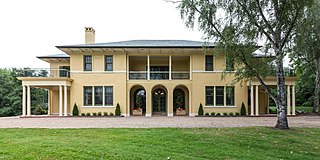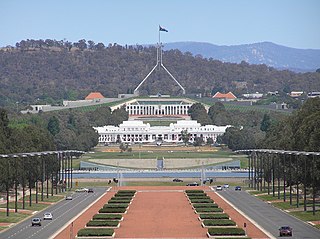
The Jervis Bay Territory is an internal Australian territory. It was established in 1915 by the transfer of jurisdiction from the state of New South Wales to the federal Commonwealth of Australia, in order to give the federal government control of a port in the vicinity of the landlocked Australian Capital Territory (ACT).

The Lodge is the primary official residence of the prime minister of Australia. Located at 5 Adelaide Avenue in the Canberra suburb of Deakin, it is situated a short distance away from Parliament House. The Lodge is one of two official prime ministerial residences, the secondary official residence being Kirribilli House in Sydney. The building was completed in 1927 in the Georgian revival style, since then twenty-three people have served as prime minister, six of whom chose to live elsewhere either full- or part-time during their tenure, and two who chose to live at Kirribilli House.

The National Library of Australia (NLA), formerly the Commonwealth National Library and Commonwealth Parliament Library, is the largest reference library in Australia, responsible under the terms of the National Library Act 1960 for "maintaining and developing a national collection of library material, including a comprehensive collection of library material relating to Australia and the Australian people", thus functioning as a national library. It is located in Parkes, Canberra, ACT.

Civic is the city centre or central business district of Canberra. "Civic" is a common name for the district, but it is also called Civic Centre, City Centre, Canberra City and Canberra, and its official division name is City.

Yarralumla is a large inner south suburb of Canberra, the capital city of Australia. Located approximately 3.5 km (2.2 mi) south-west of the city, Yarralumla extends along the south-west bank of Lake Burley Griffin from Scrivener Dam to Commonwealth Avenue.

Deakin is a suburb of Canberra, Australian Capital Territory, Australia. Development began in the 1920s, although the vast majority of the suburb was built after 1945. It is a largely residential suburb. It includes The Lodge, and the Royal Australian Mint.

Reid is a suburb of Canberra, Australian Capital Territory, Australia. With a population of 1,544 at the 2021 census, located directly next to Civic, Reid is one of the oldest suburbs in Canberra. It is named after George Reid, the fourth prime minister of Australia.

Braddon is an inner north suburb of Canberra, Australian Capital Territory, Australia located adjacent to the Canberra CBD.
Forrest is a suburb of Canberra, Australian Capital Territory, Australia. Forrest is named after Sir John Forrest, an explorer, legislator, federalist, Premier of Western Australia, and one of the fathers of the Australian Constitution. Streets in Forrest are named after explorers and governors. According to the Australian Bureau of Statistics Forrest is the second most Socio-Economic advantaged location in Australia after the neighbouring suburb of Barton.

Barton is a suburb of Canberra, Australian Capital Territory, Australia. At the 2021 census, Barton had a population of 1,946 people.

Kingston is the oldest and one of the most densely populated suburbs of Canberra, Australian Capital Territory, Australia. The suburb is named after Charles Cameron Kingston, the former Premier of South Australia and minister in the first Australian Commonwealth Government. It is adjacent to the suburbs of Barton, Fyshwick, Griffith and Manuka. The suburb of Kingston is situated about 4 km from the centre of Canberra.

Old Parliament House, formerly known as the Provisional Parliament House, was the seat of the Parliament of Australia from 1927 to 1988. The building began operation on 9 May 1927 after Parliament's relocation from Melbourne to the new capital, Canberra. In 1988, the Commonwealth Parliament transferred to the new Parliament House on Capital Hill. Since 2009, Old Parliament House has become a museum about the building and Australian democracy more broadly, named the Museum of Australian Democracy at Old Parliament House (MoAD). It also serves as a venue for temporary exhibitions, lectures and concerts.

Commonwealth Park is in Canberra, Australia, adjacent to the north side of Lake Burley Griffin. Centrally located in the city, it is an important part of the urban landscape. The park has an area of 34.25 hectares, which includes a variety of natural and constructed spaces.

John Smith Murdoch was a Scottish architect who practised in Australia from the 1880s until 1930. Employed by the newly formed Commonwealth Public Works Department in 1904, he rose to become chief architect, from 1919 to 1929, and was responsible for designing many government buildings, most notably the Provisional Parliament House in Canberra, the home of the Parliament of Australia from 1927 to 1988.

The Australian Institute of Architects, officially the Royal Australian Institute of Architects, is Australia's professional body for architects. Its members use the post-nominals FRAIA (Fellow), ARAIA and RAIA. The Institute supports 14,000 members across Australia, including 550 Australian members who are based in architectural roles across 40 countries outside Australia. SONA is the national student-membership body of the Australian Institute of Architects. EmAGN represents architectural professionals within 15 years of graduation, as part of the Australian Institute of Architects.

Blundells Cottage is a heritage-listed six-roomed stone cottage located on the northern shore of Lake Burley Griffin, in Canberra, Australia. The cottage was built by George P. Campbell in about 1858 for his ploughman William Ginn on the original Molonglo River floodplain. Ginn lived there with his family until 1874 and then Flora and George Blundell moved in and remained there until about 1933. Flora was a midwife and George a bullock driver for Campbell. In 1913, the Duntroon estate was acquired by the Commonwealth of Australia to form part of the new Federal Capital Territory, although the Blundells continued to live there. Then, Harry and Alice Oldfield moved to the cottage in 1933.

Emil Lawrence Sodersten was an Australian architect active in the second quarter of the 20th century. His work encompassed the Australian architectural styles of Art Deco and Functionalist & Moderne. His design for the Australian War Memorial was "the first national architectural monument in Australia". The Australian Institute of Architects presents the Emil Sodersten Interior Architecture Award annually in his honour.

The Canberra Times is a daily newspaper in Canberra, Australia, which is published by Australian Community Media. It was founded in 1926, and has changed ownership and format several times.
The Mugga Lane Zoo was a privately owned zoo located on Mugga Lane in the Australian capital city of Canberra. First opened in 1979 as the Canberra Wildlife Gardens, It was the first permanent zoo in the city, predating the National Zoo & Aquarium by over a decade. In 1981 the park was rebranded as the Mugga Lane Zoo, although the Canberra Wildlife Gardens name continued to be occasionally used until 1986. Before its closure in 2002, the zoo displayed over 116 different species of animals in its 9 ha (0.035 sq mi) park. Today, the now abandoned site remains a well known location in Canberra due to its popularity with urban explorers, and as a likely source of the feral peacocks often seen around South Canberra. According to the founder, Terry Thomas, the zoo was never financially successful, in part due to difficulties experienced attaining animal permits from the Department of the Capital Territory.
Walter Construction Group Limited, known for most of its life as Concrete Constructions Pty Ltd, was one of Australia's oldest and fifth largest construction company prior to its 2005 collapse. The company was founded on 21 April 1920 by Allen Lewis. It remained independent until 1999, when the company was bought by the German Walter Bau and rebranded as Walter Construction Group.


















